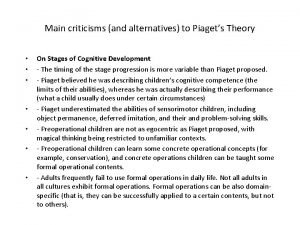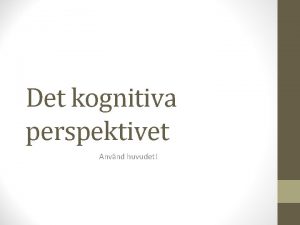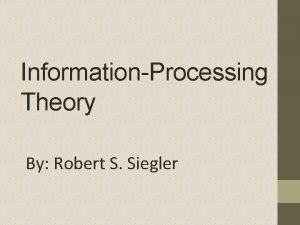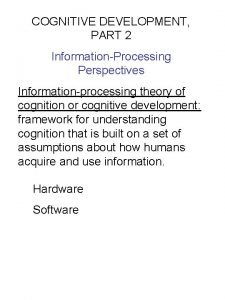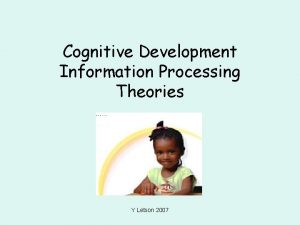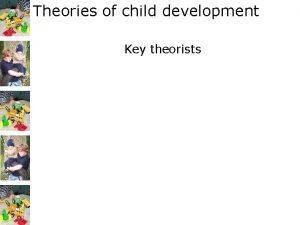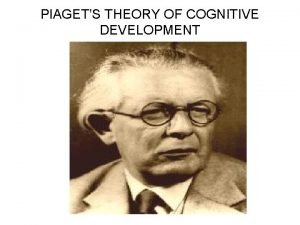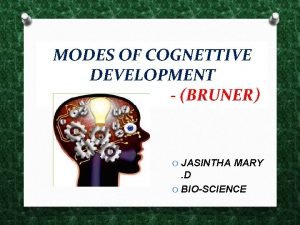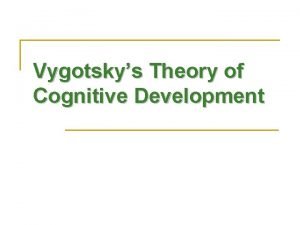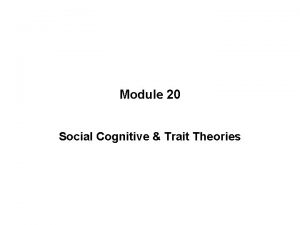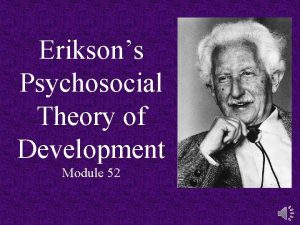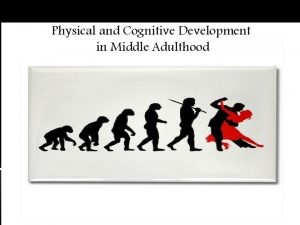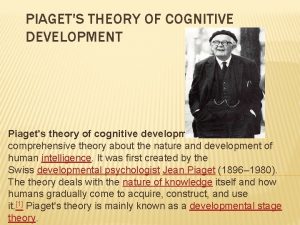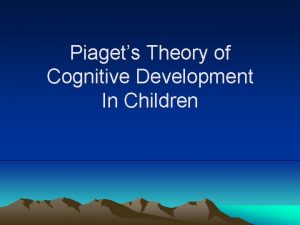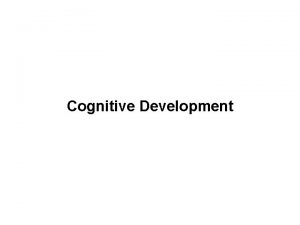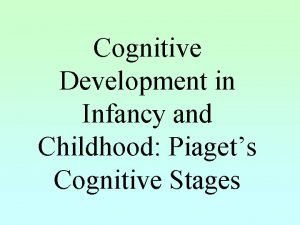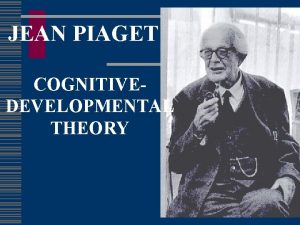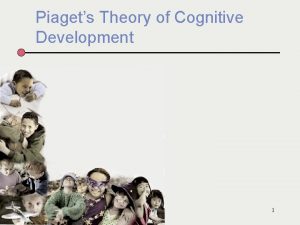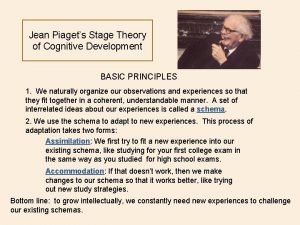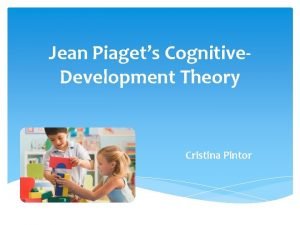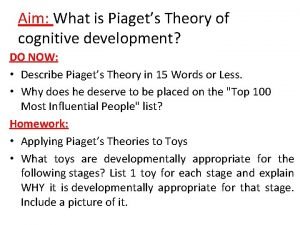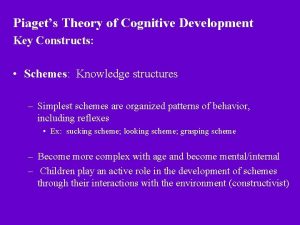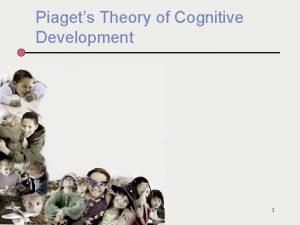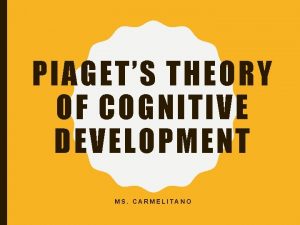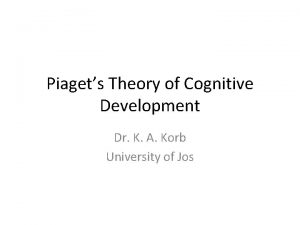Chapter 7 Piagets Theory of Cognitive Development Module

























- Slides: 25

Chapter 7: Piaget’s Theory of Cognitive Development Module 7. 1 General Principles of Piaget’s Theory Module 7. 2 Piaget’s Four Stages of Cognitive Development Module 7. 3 Evaluating Piaget’s Theory Module 7. 4 Beyond Piaget’s Theory Children and Their Development, 3/e by Robert Kail

7. 1 General Principles of Piaget’s Theory Schemes Assimilation and Accommodation Equilibration and Stages of Cognitive Development

7. 1 Schemes • Schemes are like categories; they organize experience and knowledge • Schemes first based on actions, then functions, and conceptions

7. 1 Assimilation and Accommodation • In assimilation, new experiences are readily incorporated into existing schemes • In accommodation, existing schemes must be changed to incorporate new information

7. 1 Equilibration and Stages of Cognitive Development • Equilibrium: when assimilation and accommodation are in balance • Periodically, schemes are inadequate and disequilibrium occurs. Equilibration is the process of reaching a new state of equilibrium • Metaphor of child as scientist • Three reorganizations of theories lead to 4 stages of cognitive development

7. 2 Piaget’s Four Stages of Cognitive Development The Sensorimotor Stage The Preoperational Stage The Concrete Operational Stage The Formal Operational Stage

7. 2 The Sensorimotor Stage • From birth to approximately 2 years • Begins with reflexive responding and ends with using symbols • Object permanence: understanding that objects exist independently

7. 2 The Preoperational Stage • From approximately 2 to 7 years • Children use symbols but are many errors in thinking > Egocentrism > Centration > Confuse appearance and reality

Three Mountains Problem 7. 2: The Preoperational Stage

Conservation Tasks 7. 2: The Preoperational Stage

Models as Symbols or “Shrinking Rooms” 7. 2: The Preoperational Stage

7. 2 The Concrete Operational Stage • From approximately 7 to 11 years • Thinking based on mental operations (strategies and rules that make thinking more systematic and powerful) • Operations can be reversed • Focus on the real and concrete, not the abstract

7. 2 The Formal Operational Stage • From approximately 11 years to adulthood • Adolescents can think hypothetically • Use deductive reasoning

7. 3 Evaluating Piaget’s Theory Piaget’s Contributions to Child Development Criticisms of the Theory

7. 3 Piaget’s Contributions to Child Development • Piaget’s contributions: > the study of cognitive development itself > a new, constructivist view of children > fascinating, often counterintuitive, discoveries

7. 3 Criticisms of the Theory • Some criticisms: > alternative accounts of performance > consistency in performance > training on Piagetian concepts > actual versus possible thinking

Object Permanence and the “Impossible Event” 7. 3: Criticisms of the Theory

7. 4 Beyond Piaget’s Theory Neo-Piagetian Approaches to Cognitive Development The Child as Theorist The Sociocultural Perspective: Vygotsky’s Theory

7. 4 Neo-Piagetian Approaches to Cognitive Development • Retain Piaget’s basic claim of stages of intellectual development • Each child develops distinct conceptual structures that reflect experience • Working memory improves with age which allows children’s thinking to become more complex

7. 4 The Child as Theorist • Builds on Piaget’s metaphor of child as scientist • Research traces children’s knowledge of > naive physics (understanding objects) > naive psychology (theory of mind) > and naive biology (understanding unique properties of animate objects)

“Impossible” Physics Problem 7. 4 The Child as Theorist

Movement in Animate and Inanimate Objects 7. 4 The Child as Theorist

Theory of Mind 7. 4 The Child as Theorist

7. 4 The Sociocultural Perspective: Vygotsky’s Theory • Cognitive development is inseparable from social and cultural contexts • Zone of proximal development: difference between what can do alone or with assistance • Scaffolding: teaching style that matches assistance to learner’s needs • Private speech: comments intended to regulate own behavior • Inner speech: thought

Cultural Differences in Parental Scaffolding 7. 4: The Sociocultural Perspective
 Criticisms of piagets theory
Criticisms of piagets theory Kognitiva schemat
Kognitiva schemat Ap psych schema
Ap psych schema Module 47 infancy and childhood cognitive development
Module 47 infancy and childhood cognitive development Bruner theory of cognitive development
Bruner theory of cognitive development What do information processing theories focus on
What do information processing theories focus on Piaget information processing theory
Piaget information processing theory Information processing theory of cognitive development
Information processing theory of cognitive development Gesell theory
Gesell theory Outline piaget's theory of cognitive development
Outline piaget's theory of cognitive development Child development: an active learning approach 4th edition
Child development: an active learning approach 4th edition Piaget theory of cognitive development
Piaget theory of cognitive development Bruner's theory of cognitive development
Bruner's theory of cognitive development Dream theories
Dream theories Vygotsky guided participation
Vygotsky guided participation Piaget's theory of cognitive development
Piaget's theory of cognitive development Cognitive and non cognitive religious language
Cognitive and non cognitive religious language Social cognitive personality
Social cognitive personality Chapter 9 early childhood cognitive development
Chapter 9 early childhood cognitive development Chapter 5 cognitive development in infancy and toddlerhood
Chapter 5 cognitive development in infancy and toddlerhood Erik erikson theory
Erik erikson theory C device module module 1
C device module module 1 Middle adulthood cognitive development
Middle adulthood cognitive development Cognitive development early adulthood
Cognitive development early adulthood Late childhood cognitive development
Late childhood cognitive development Late adulthood intellectual development
Late adulthood intellectual development
